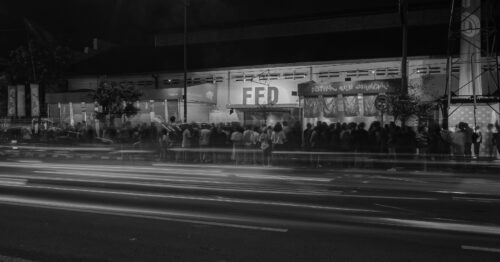Unlike other artist talks or interactive discussions, DOC Interactive’s presentation on Thursday, December 7, 2023, provided a different experience for the audience. Whereas in these kinds of events, the audience generally sits on chairs and the conversation is channeled through loudspeakers, in this talk, the audience and speakers sat on the same floor as one another. There were no chairs, couches, and speakers. As such, in the company of the artists, Sirin Farid Stevy and Rangga Purbaya, the DOC Interactive: Faith in Speculations (FIS) artist talk was intimate and felt like a hangout with fellow friends.

Right in front of the installation, the talk began with a presentation by Rangga Purbaya, who explained how the visual website, which features red dots, works. These dots are where narratives of memory about the 1965 incident and the stories surrounding it are documented. He also explained each of the available features that can be accessed through the fis.1965.or.id/ page link. The narratives obtained by Rangga Purbaya and Sirin Farid Stevy are the result of research and personal stories of the search for Sirin’s grandfather by Farid and his family. The ongoing data collection also provides an opportunity for the public to contribute to the narrative about the intricacies of the story about and/or around the events of 1965.
Also present on this occasion was one of the FIS website developers, Debby Gea. She and Wawan are the people behind the FIS 1965 website to translate the data and narratives that have been collected. Their efforts are a form of digitizing the memories of this gripping event.
Responding to a question about the sustainability of the FIS platform in the midst of technological changes (read: shifts), Rangga explained that FIS will always follow technological advances and adjust the available platforms. Farid added that beyond the issue of the possibility that the 1965 narrative will be conveyed to the next generation, the most important thing in this effort is how this story can be heard. Equally important is the search for ways to bring this platform to its intended audience.
The dialog that took place in the discussion room was not only focused one way, but became a fluid dialog between all those who were attending, both the speakers and the visitors. The visitors also shared their own narratives related to the events of 1965. Agnes, one of the visitors, shared a personal story about the events of that year that she learned from her grandmother.

Rangga also explained the process of moderating the narratives and data included in the FIS project. Together with his team, he moderated the incoming narratives by sorting and selecting narratives from primary sources and derivative narratives by validating the logicality of the narrative. While explaining, he also skillfully practiced and showed the data contained in the FIS page.
Narratives of soccer, arrests, partisans, and exiles from the events of 1965 are woven through the red dots of the FIS project. The dots indicate the location where the narrative took place with “almost” specifics, but some of them are deliberately obscured for security reasons. The project initiated by Farid and Rangga is a long-term project to collect narratives that were “lost” before, during, and after the events of 1965. For some time to come, any visitor to the website can submit their narrative as part of the FIS narrative. These narratives can then be used as a medium to preserve memory through this project.
Covered by Ahmad Radhitya Alam on December 8, 2023.



